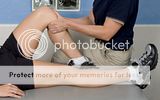Do you train when you are injured? Should you train
when you are injured? Of course it depends to some extent on the nature of the
injury and whether surgery or other medical intervention is required to correct
it.
I had an e-mail from someone who had fairly
recently taken up martial arts but had sustained a shoulder injury requiring
surgery and her doctor had advised her to stop doing martial arts. She was
asking me what I thought about this advice and whether I had sustained injuries doing martial arts.
Well, who hasn’t sustained some kind of injury doing
martial arts? Anything from bumps, bruises, sprains or pulls to ACL tears,
rotator cuff injuries, fractured ribs or noses – you name it, it will have
happened to someone. It is almost
inconceivable that you will never sustain some kind of injury when you train in
martial arts – it’s an occupational hazard!
Surely if we gave up a physical activity every time we
were injured we would soon become a world of couch potatoes. Being prepared to
risk physical injury and endure the pain of it whilst training on is part of
the mental and spiritual development that martial arts are known for.
I had a chronic ‘quad’ injury last year when preparing
for my black belt training. I could barely lift my knee up let alone kick with
that leg. It didn’t occur to me to stop training until it healed! However I was
highly motivated to speed up the healing process (6 weeks from grading) and
eventually got relief from a deep tissue massage. Now I have a chronic shoulder
injury. I have had a course of physiotherapy which has brought about some minor
improvement and I’m planning to try another deep tissue massage to my shoulder,
neck and back. However, I have continued to train throughout, putting up with
the discomfort and pain afterwards.
My husband continues to train with a chronic hip
problem – he literally hobbles home sometimes. My husband is a doctor; if he
were his own patient he would probably advise himself to stop doing martial
arts. However, this advice would only help his hip (or maybe not – it might get
worse with no exercise!) but it wouldn’t help him – he is a whole person, not
just a hip. He would be miserable if he couldn’t carry on with training – he’d
rather put up with the pain!
How far should we be prepared to go training with a
chronic injury? I am always impressed with the courage and fortitude of people
who fight back to fitness after a serious injury so they can continue enjoying
the activity they love. Michele fought back from her ACL tear a few years ago
and has now just been awarded her 6th dan. Likewise, Middle-AgedMartial Artist tore his ACL during his black belt test but fought back to
re-take the test a couple of years later. Tiger Lady is fighting back following
a brain injury caused by boxing. I’m sure you can all name someone who didn’t
give up their martial art because of an injury and fought back to fitness,
probably in spite of their doctor’s advice.
Of course there are things we can do to minimise our
chance of injury. Injuries often happen because muscles are not strong enough
to stabilise joints, or our posture is bad or our technique is incorrect.
Keeping our bodies in tip-top condition is a necessary part of martial arts
training. Good posture, muscle tone, flexibility, general body movement, as
well as good technique – particularly for throwing where you need to bear the
full weight of your partner- will help to reduce the chances of injury and help
to speed up recovery if it happens.
In my opinion (and I’m not a doctor) unless it is
actually fractured, dislocated, sprained to the point you can’t weight bear,
bleeding heavily, just been operated on or has rendered you unconscious there
is no need to stop training. Grin and bear the discomfort and train on. If it’s
bad enough to put you out of action for a while then phase your return as you
build up your fitness again – but don’t give up all together.
Remember! You
are more than the sum of your parts. You are certainly more than your injury so
don’t be defined by it. What’s best advice for your injury isn’t necessarily
best advice for your whole person – you just have to be more sensible about the
way you train in future. There are people out there training from wheelchairs,
now that’s to be admired!
If you are determined to succeed you will find a way …
Happy training!
Disclaimer: I am not a doctor so don't take this post as advice on whether you can train with your injury. It's your injury so it's your call....

This work is licensed under a Creative Commons Attribution-Noncommercial-Share Alike 2.0 UK: England & Wales License.




